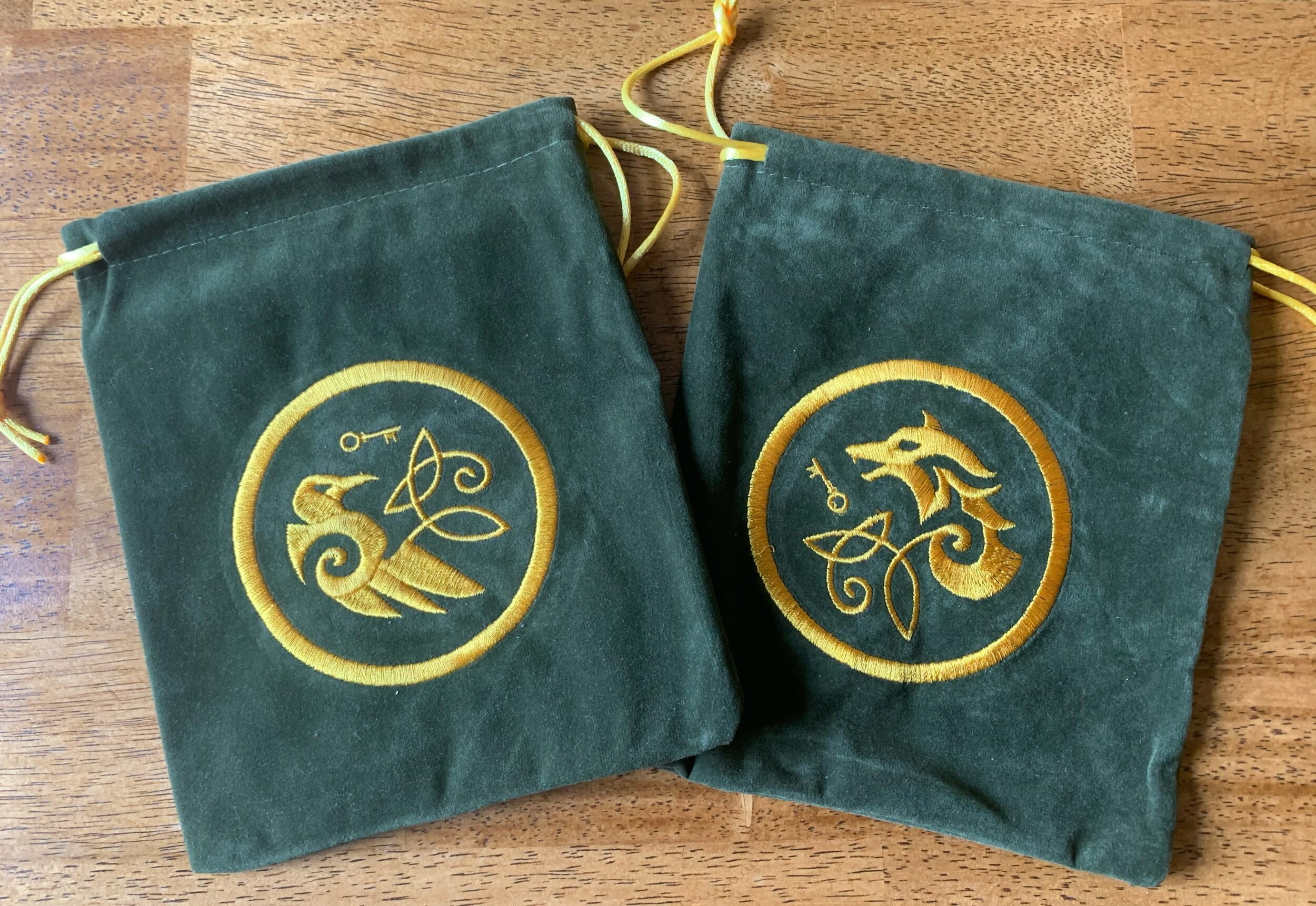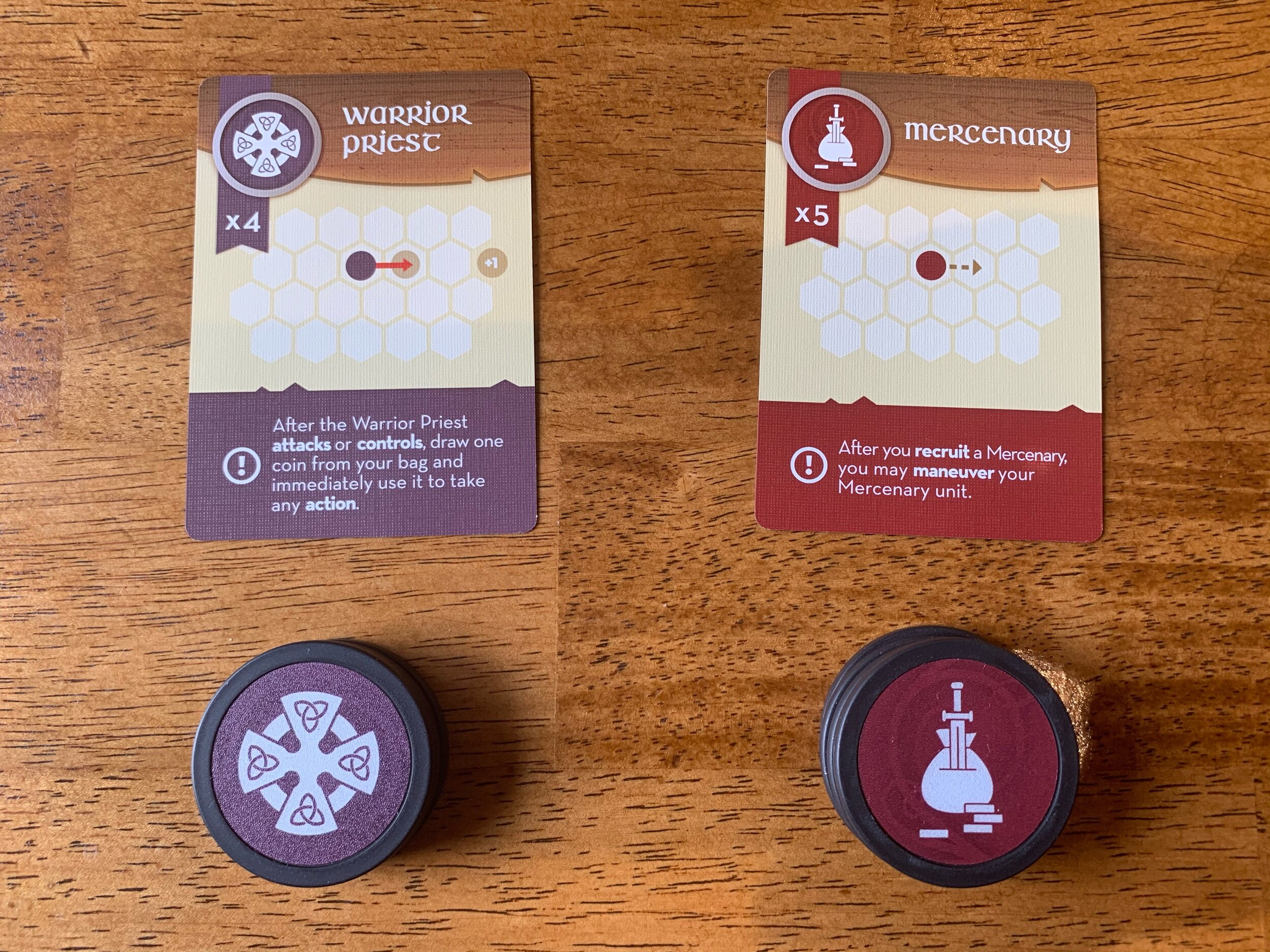What Is It Good For? A Double-Take Review of War Chest
/You look across the field at your enemy. The slight breeze brings the smell of death to your nostrils. Your gut says you should make your way to that vital hilltop, but you’re not sure if the enemy has it in his power to stop you. You order your Light Cavalry toward the hill, and realize by the look on the other commander’s face that he can’t do anything about it. The days is yours. This is how it feels to play War Chest, an abstract, hand-management, bag-building wargame from Alderac Entertainment Group for 2 or 4 players that plays in 15-30 minutes. It uses awesome and gorgeous poker-type chips to represent units. So does this game go all-in, or is it a bad beat? Let’s find out!
The Setup
(We’re going to explain this using the 2-player setup; it can also be played with 4 players on teams.)
Place the board in the middle of the table, and each player takes a matching draw bag, Royal Coin, and six Control markers. The bags are nicely embroidered and should last a long time. Each player place two of their Control markers on the starting spaces near their side of the board.
The base game comes with 16 different Units, and each player will control four different ones each game. There’s a suggested, balanced distribution for your first few games, and after that you’re just supposed to shuffle the 16 cards and randomly deal four to each player. However: There’s an alternate rule where you draft Units and this is clearly the best way to do it once you’ve got a few games under your belt. As far as we’re concerned, that IS the setup rule.
So once you’ve determined who gets what Units, each player takes the matching Unit Coins and Unit Cards, puts two of each Coin in the bag—along with their Royal Coin—and then flip the Initiative marker to determined who starts.
The Gameplay
There are six neutral location spots on the board, and the goal is to place out all six of your Control markers—keeping in mind you start with two of them on the board already. Once you place all six Control markers, you immediately win.
The game is played over a series of rounds, and each round has two phases: 1) Draw Coins, and 2) Use Coins.
Each player draws three Coins from his or her bag. If there aren’t enough in the bag to do so, you draw as many as are in the bag, and then place all of the coins from your discard pile into the bag, shuffle the Coins, and continue drawing until you have three Coins. Keep them hidden from your opponent.
There are three different types of Actions you can take with each Coin: Placement Actions, Discard a Coin Face-Down Actions, or Discard a Coin Face-Up Actions. Let’s go through each.
Placement Actions
Deploy: You Deploy a Coin to the board, creating a Unit of that type.
It has to go on a location you control, and if you don’t control any locations, you can’t Deploy.
You can only have one Unit of each type on the board at any time, so if there’s already one of that Unit on the board, you can’t Deploy. (Some specific Units allow you to break this rule.)
If you’ve removed the last Coin of a Unit from the board because of an attack, you can later Deploy that Unit again.
Bolster: You place a Coin onto a matching already Deployed Unit, making it stronger, and more difficult to defeat in an attack.
There’s no limit to the size of a Unit stack—other than the number of those Coins in the game.
If a Unit moves, the whole stack moves with it.
Discard a Coin Face-Down Actions
Claim Initiative: You place any Coin face-down into your discard pile to claim the Initiative marker.
If you already have the Initiative marker, you can’t perform this Action.
Recruit: You place any Coin face-down into your discard pile to Recruit a new Coin from the supply.
Take any one Unit Coin from your supply, show it to your opponent, and place it face-up in your discard pile. This Unit will be shuffled into your bag in a later round.
The Unit you Recruit does NOT have to match the Coin you used to Recruit it.
Pass: You place any Coin face-down and pass.
If you have Coins remaining when it comes back to you, you can do anything you want; you don’t have to Pass. So this can be a delaying tactic.
Discard a Card Face-Up Actions
Move: Discard a Unit Coin face-up to move that matching Unit on the board.
The Unit can move to one, adjacent empty space.
Control: Discard a Unit Coin Face-Up and have the matching Unit Control the location it occupies.
If the Unit is on a Neutral location (one with no marker on it), you just take Control and place your Control marker on it.
If the location has your opponent’s Control marker on it, you replace theirs with yours.
Each location can only have one marker on it, so don’t try to just occupy one location and keep stacking Control markers on it until you win. Cheater…
If you place your last Control marker on the board, you win!
Attack: Discard a Unit Coin Face-up to have the matching Unit on the board attack an adjacent enemy Unit.
Remove one Coin from the target stack and place it out of the game, into the box. If it’s the only Coin in the stack, that Unit is no longer considered Deployed on the board. It can be Deployed later if there are still Coin of that type available to the player.
Tactic: Discard a Unit Coin face-up to perform the Tactic from the matching Unit.
Only some Units have Tactics.
Let’s take a look at the “starting” eight Units so we can get an idea of what’s in the game (the number is parentheses is how many Units are in the game).
Swordsman (5): After the Swordsman attacks, it may move.
Pikeman (4): When a Pikeman is attacked by an adjacent Unit, also remove a Coin from the attacking Unit.
Crossbowman (5): Tactic: Attack a Unit two spaces away in a straight line. The intervening space can’t be occupied by a Unit of either side.
Light Cavalry (5): Tactic: Move two spaces.
Archer (4): Tactic: Attack a Unit two spaces away. The intervening space can be occupied by a Unit. (The Archer can ONLY attack using its Tactic.)
Cavalry (4): Tactic: Move and then attack.
Lancer (4): Tactic: Move one or two spaces, and then attack, all in a straight line. (The Lancer can only attack using its Tactic.)
Scout (5): The Scout may be Deployed adjacent to any friendly Unit.
And that’s only half of the Units that come in the base game. As you can see, the Units are varied and unique.
Variant
You can play War Chest with four players—two teams of two. You play on a larger portion of the game board, and each player only has three Units to control. You only control and affect your own Units but your teammates’ Units are considered friendly for the purpose of Tactics. All communication between teammates is open. Teams share locations, and start by controlling three locations, rather than two. Teammates sit across from each other so teams will alternate play.
The Verdict
This image contains Coins from the expansion, too.
Firestone—Obviously the Coins are AWESOME. They’re heavy, quality, and just gorgeous. I love the symbols they chose. I love the colors they chose. It’s all very clear from anywhere what the Unit is.
Jeremiah—It’s great that the Coins are basically high-quality poker chips, while a large component of the gameplay is almost a poker-esque stare between you and your opponent as you try to plan out your moves while trying to predict the Coins they hold as well. It’s perfectly delicious!
Firestone—I have to be honest: I wasn’t sure how this was going to play out. I wondered if it would feel like chess (a game I don’t enjoy) but it was quickly clear that this isn’t much like chess (there’s luck, for one). It was also quickly clear that the game is full of interesting decisions. Do I add another Unit to the bag? Do I use this Coin to Bolster? To move? To attack? It’s tense.
Jeremiah—Yes! The fact that your Coins are both a “worker” AND a resource takes some fairly easy to understand actions and piles on a ton of weight to them. Sure, you can have that unit bolstered and beefed up, but it’s more likely it’s going to sit there and do nothing because you can’t move it until you draw that one remaining Coin of its type. But I also love that you can decide to craft your bag a specific way leaning heavily on specific types of coins depending on how you want to attack/counter-attack your opponent’s strategy.
Firestone—I appreciate that you only have three coins each turn, so your options are somewhat limited, which keeps you from getting overwhelmed with choices.
Jeremiah—Which definitely goes back to how you decide to load up your bag. You can increase your odds of pulling specific ones if you really want to focus on a certain strategy.
Firestone—One of my favorite things about War Chest is the sort of bluffing thing that happens. You’re always wondering if your opponent has the Coin to take a location, or to keep you from taking it, or to attack you. You can see what’s in the discard face-up, but you’re not always sure what’s in his hand or what’s in his bag. Or what’s face-down from a previous turn. I love that game of chicken.
Jeremiah—Hahaha I love to torment opponents with face-down coins. “Mmmmmaybe I can’t attack you now, mmmmaybe I can!” The really great thing about this game is that you’re playing your opponent as much as you are moving game pieces on a board—very interactive, always engaged, and plenty of juicy tension!
Firestone—I played with four players only once, and it was a good option. I would absolutely do it again. But I prefer to play this with two players.
Jeremiah—Same here, I think we ran it back after we played four players with different cards, etc. I actually don’t think I’ve ever played just once. We always want to play again, we usually discard the cards we just played with and deal out new units to each side, which is a great way to explore all of the different unit types and grasp the game really well.
Firestone’s Final Verdict—War Chest is excellent. It’s a terrific mix of special powers, simple rules, clever gameplay opportunities, and fun combos. Every game has been a fun and tense experience, and I can’t wait to explore it further.
Jeremiah’s Final Verdict—War Chest might be my favorite game of the last year… or whenever it came out… (Sorry, pandemic brain). It’s a great game that isn’t too fiddly, encourages all players to be engaged throughout and rewards clever play. I cannot recommend this game enough!
Have you played War Chest? What are your favorite Units? Let us know in the comments, and thanks for reading!



















